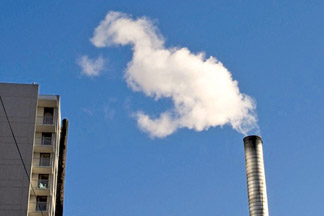Global Warming & climate change issues remain unresolved
Dr N Yogaratnam
Global warming has become perhaps, the most complicated issue facing
world leaders. Warnings from the scientific community are becoming
louder, as an increasing body of science points to rising dangers from
the ongoing buildup of human-related greenhouse gases - produced mainly
by the burning of fossil fuels and forests.

Global emissions of carbon dioxide were at a record high in 2011and
were likely to take a similar jump in 2012, scientists reported in early
December 2012 - the latest indication that efforts to limit such
emissions are failing.
Global emissions
Over all, global emissions jumped thre percent in 2011 and are
expected to jump another 2.6 percent in 2012, researchers reported.
The new figures show that emissions are falling, slowly, in some of
the most advanced countries, including the United States. That
apparently reflects a combination of economic weakness, the transfer of
some manufacturing to developing countries and conscious efforts to
limit emissions, like the renewable power targets that many American
states have set. The boom in the natural gas supply from hydraulic
fracturing is also a factor, since natural gas is supplanting coal at
many power stations, leading to lower emissions.
But the decline of emissions in the developed countries is more than
matched by continued growth in developing countries like China and
India, the new figures show. Coal, the dirtiest and most
carbon-intensive fossil fuel, is growing fastest, with coal-related
emissions leaping more than 5 percent in 2011, compared with the
previous year. Emissions continue to grow so rapidly that an
international goal of limiting the ultimate warming of the planet to 3.6
degrees, established three years ago, is on the verge of becoming
unattainable, said researchers affiliated with the Global Carbon
Project, a network of scientists that tracks emissions.
Yet nations around the world, despite a formal treaty pledging to
limit warming and 20 years of negotiations aimed at putting it into
effect have shown little appetite for the kinds of controls required to
accomplish that goal.

For almost two decades, the United Nations has sponsored annual
global talks, the United Nations Framework Convention on Climate Change,
an international treaty signed nearly 200 countries to cooperatively
discuss global climate change and its impact. The conferences operate on
the principle of consensus, meaning that any of the participating
nations can hold up an agreement.
Doha negotiations
Last year's U.N. Framework Convention on Climate Change conference,
held in Doha, Qatar, ended in December 2012, with mixed results.
After a 48-hour marathon negotiating session which unfortunately has
become typical in these yearly meetings one of the three decisions made
by the negotiators ultimately is: The Kyoto Protocol was reauthorized
for another eight years, though fewer countries signed on so it now only
covers some 12 percent of global emissions.
In general, the response to the meeting's outcome has thus far been
varied, but as with most of these climate summits, many consider it far
from adequate to address the growing climate crisis. It has been called
as a "modest step toward a global climate deal."
The Kyoto Protocol-the world's only legally binding agreement on
emissions reductions finalized in 1997-was set to expire at the end of
December, 2012, which could have terminated the global carbon market
mechanisms that have been established to support it. A majority of
countries agreed, though, to extend the protocol into a second term.
This second commitment period will begin on January 1, 2013, and will
conclude on December 31, 2020.
Durban track treaty
It will thus bridge the gap between the end of the first Kyoto
commitment period and the beginning of the next legally binding climate
agreement, which ideally will be finished in the Durban Platform track
in 2015, though the new treaty isn't set to take effect until 2020 at
the earliest.
|

It will thus bridge the gap between the end of the first
Kyoto commitment period and the beginning of the next
legally binding climate agreement, which ideally will be
finished in the Durban Platform track in 2015, though the
new treaty isnít set to take effect until 2020 |
Unlike the Durban track treaty, which will be universally binding for
all nations in the U.N. climate convention, the second commitment period
of the Kyoto Protocol establishes obligatory emissions cuts only for
those industrialized countries who have ratified it-at this point, only
the European Union and a handful of other parties, including Australia,
Norway, and Switzerland. Others that participated in the first period of
the protocol, such as Japan, Russia, Canada, and New Zealand, have opted
out of the second period for a variety of reasons, one of which being an
aversion to signing a treaty that did not include the world's biggest
emitters.
The second period does not cover the United States, which signed but
never attempted to ratify the original protocol in the Senate, and it
does not bind developing countries, such as China and India, to
emissions reductions. The United States and China are the world's
largest greenhouse gas emitters.
Agreement on the transition to the new commitment period for the
Kyoto Protocol was not without controversy. Strong differences of
opinion, specifically from the Russian Federation, cropped up as the
negotiations were concluding.
Although the Russian Federation opted out of the second period, its
area of concern throughout the negotiations was the carryover of surplus
"assigned amount units," or permits for allowable emissions that were
not redeemed during the first period of the protocol, into the second
period.
Russia insisted that unused permits-also known as "hot air"-be
transferred to the second period, despite significant opposition from
other nations. Surplus assigned amount units are held predominantly by
eastern European countries, whose economies collapsed after the fall of
Communism. They received credits for the carbon emissions that they
never produced but would have been allowed to, given an assessment of
their economies before the protocol went into effect.
Contrary to the Russian objections, however, the new agreement does
allow transfer of surplus assigned amount units to the second commitment
period, over the objection of many blocs of countries such as the least
developed countries and the Alliance of Small Island States.
Nonetheless, the treaty does try to limit their environmental damage.
The second term of the protocol mandates that a country "may acquire
units from other Parties' previous period surplus reserve accounts into
its previous period surplus reserve account up to 2 percent of its
assigned amount for the first commitment period." This would limit the
amount of "hot air" that can be carried over into the second commitment
period of the treaty.
Moreover, in a heartening display of principle, parties such as
Australia, the European Union, Japan, Lichtenstein, Monaco, Norway, and
Switzerland all pledged during the final negotiations not to purchase
excess units.
Kyoto Protocol
Unfortunately, the second commitment period of the Kyoto Protocol
will have a negligible effect on global emissions because the countries
that are now bound by it to reduce their emissions produce less than 15
percent of total global emissions. But it is not useless.
CDM - Grim Future after Doha
The extension of Kyoto will also serve as a basis for a globally
binding treaty and a working carbon market in 2020 by keeping intact
market-based mechanisms such as the Clean Development Mechanism, which
allows for limited trading of emission reductions across boarders.
The complicated procedures and mechanisms governing these trades,
which pay billions of dollars for clean energy projects in developing
countries every year, can be used to later serve as a basis for a treaty
that aspires to cover all emissions around the world.
Negotiations at COP18 on the future of the Clean Development
Mechanism (CDM) started off with some good options in the negotiating
text prepared by the Chair. However, throughout the sessions on the CDM,
the draft negotiation text was remarkably weakened and the final version
does not address the significant quality concerns recently highlighted
by scientists.
For example, new findings from the CDM policy research team show that
large-scale power supply CDM projects (such as large hydro and coal
power projects) are unlikely to be additional and therefore lead to an
increase in global emissions.
Despite the fact that such projects are expected to deliver more than
half of all CDM credits by 2020, policy solutions that would eliminate
these fake carbon credits where not even considered. Instead, the final
decision allows for more flexibility and less stringent testing.
Other suggested improvements, such as clarity about the consequences
of a Party withdrawing a letter of approval and important liability
measures for auditors, were removed from the final text.
Suggestions to enhance the contribution of CDM projects to
sustainable development were rejected as well. One of the key decisions
was the launch of the overall review of the modalities and procedures of
the CDM, which will take place in the course of 2013. Against the
political unwillingness to address quality issues of the CDM and the
current over-supply of about 4 Gigatonnes of CO2 it is hard to imagine
how this review will be able to rescue the CDM. With a carbon market
price of 50 cent per tonne of CO2, it is impossible to implement
projects that are additional. Key COP18 decisions on the CDM include:
Natural rubber
With many Kyoto Protocol and CDM issues still remaining unresolved,
eligibility and trading of carbon by rubber plantations may look
uncertain. Also, latex yield of rubber trees is mainly determined by
physiological factors and harvesting intensity.
Both these factors are influenced by clonal characteristics,
agronomic practices and environment. Given the physiological factors and
agronomic practices, the major yield-limiting factor is harvesting
intensity which, in turn, is mainly determined by weather and price
factors.
Extreme weather in terms of long and intense dry spells and heavy
rains can substantially reduce harvesting intensity through reduced
tapping days. The response of growers to the prevailing rubber prices is
also reflected in harvesting intensity. The interplay of weather and
price factors in determining natural rubber (NR) production makes it
difficult to forecast the influence of weather factors on price
formation.
|

Fireworks are launched over Jakartas main business road to
mark the new year in Jakarta on January 1, 2013 . AFP |
|







